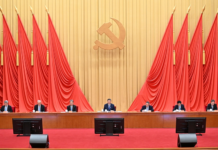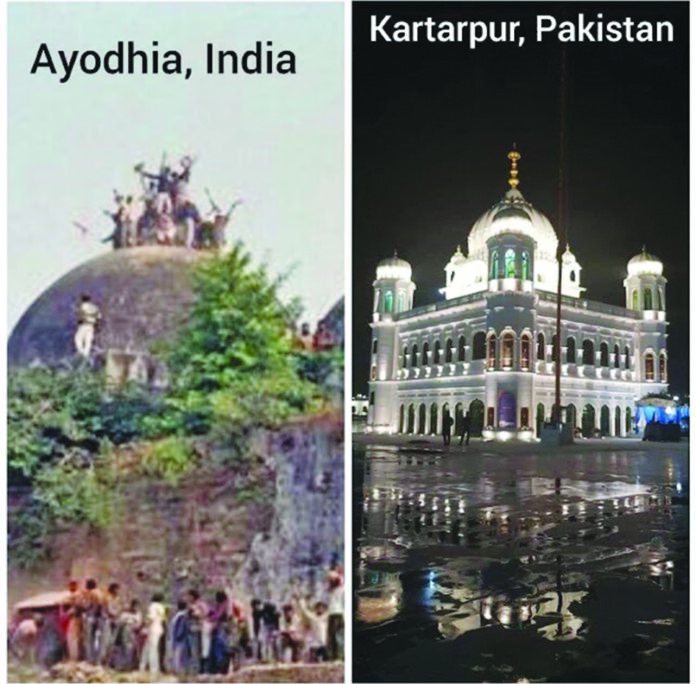Religious tolerance entails the capacity to respect and value spiritual values, beliefs, and practices that differ from one’s own. However, this goal is hard to achieve due to the diverse array of religions and spiritual beliefs existing in today’s world, often leading to annihilation of religious harmony. South Asia is a region known for its rich religious and cultural tapestry. It boasts a lengthy history marked by various events unveiling religious harmony and tolerance among its nations. Among these events, the Kartarpur Corridor and Babri Masjid stand out as pivotal instances. Both of these instances highlight the complex dynamics of religious tolerance and harmony in India and Pakistan, offering insights into the complex interplay of history, politics, and societal cohesion.
Kartarpur Corridor:
Kartarpur Corridor is a “Holy Land” for Sikh religion. The founder of the Sikh religion “Baba Guru Nanak Dev Ji” spent the last 18 years of his life at Kartarpur. The Gurdwara is considered to be the most sacred Shrine of the Sikh religion. The original abode (Gurdwara) was established by Guru Nanak in 1515 later washed by the floods from the river Ravi.
The present-day abode was built by Maharaja Ranjit Singh in the 19th century. After the Partition in 1947, the Sikh Community migrated to India and the Gurdwara was left abandoned. Since 1947 Sikh Community of India and across the world was desirous of access to the Gurdwara from India because it’s just about 4-5 Km from Pakistan-India Border. Kartarpur Corridor is functioning under a Memorandum of Understanding (MoU) between Pakistan and India. Around 5000 Yatrees (Pilgrimages) are allowed to enter from the Indian side on a daily basis, however, now due to security issues they are allowed to enter only when there is a specific festival.
Kartarpur holds a huge religious and cultural significance as it shows and promotes unity and understanding among people belonging to different backgrounds. People from all over the world come together to honor the teachings of Baba Guru Nanak. It is also a reminder of Sikh culture, heritage, religious sentiments, roots and the vast history behind it. The corridor is also a symbol of peace and cooperation between Pakistan and India, allowing Sikhs to cross
borders in pursuit of their religious spirituality. It also fulfills the long-held dream of many Sikhs to visit the Baba Guru Nanak’s Gurdwara.
Babri Masjid:
On the contrary, a Temple popularly known as “Ram Mandir” is being constructed on the land where once stood a mosque known as “Babri Masjid”. It was claimed by Hindus that it is the birth place of Ram Deity and that there stood a temple before the mosque.
This mosque was built by Mughal Commander Mir Baqi under the Mughal king, Babar in 1528. In 1949, the mosque was declared a disputed property after the Hindu Priest allegedly placed the idols of Ram deity inside it. No Muslim offered prayers at the mosque since then. In 1950-61, a civil suit was filed by Muslims groups and far-right Hindus to seek possession of the site. BJP also carried out various protests to demolish the mosque and build a temple instead. Later in 1992, Hindu nationalist mob gathered in Ayodhya and demolished the mosque. An archeological survey was conducted of the site to know whether a temple existed here or not. However, the archeologists and Muslims had contrasting views on the findings.
The case regarding the custody of this land lingered in the court for an extended period, but later in November 2019, the supreme Court of India ruled that the land must be handed over to a trust to oversee the construction of a Hindu temple. A separate piece of land was awarded to Muslim group in Ayodhya. A Trust named “Shree Ram Janmabhoomi Teerth Kshetra Trust” is set up to oversee the construction and management of the temple. On January 22, 2024, the temple was inaugurated despite the pending construction of some of its wings. This activity was carried out by Prime Minister of India; Narendra Modi himself.
The inauguration of the temple before the 2024 elections can be perceived as a political tactic by the BJP. This is because the BJP has consistently propagated anti-Muslim narratives and this move could be seen as an attempt to garner votes by capitalizing on sentiments against Muslims. Choosing to inaugurate a temple at a site with historical significance to Muslims, provides them with an opportunity for securing more votes.
Analysis:
The Kartarpur Corridor and Babri Masjid Incident both show how India and Pakistan have different approaches towards the challenges surrounding diverse religious sentiments in pluralistic society. Pakistan’s approach towards other religions is more welcoming and subtler. This suggests that people of Pakistan tend to be more open minded and tolerant
towards people of different faiths. There exists a culture of inclusivity and hospitality towards followers of various religions. This approach is reflected in nations policies and societal norms which promotes the atmosphere of co-existence. People belonging to different faiths have restrictions on practicing their religions and celebrating their festivities. Moreover, it is common for communities of various faiths to come together for shared cultural experiences. This not only shows the openness and tolerance of Pakistani people but also showcases a means of promoting interpersonal relations.
Conversely, India has a violent and resentful approach towards different religions. It reflects India’s religious extremist narratives and a varying perspective on historical and sacred places of other religions. There are many instances like Babri Masjid where the Indian community has shown intolerance and discrimination against other minority religions and taken biased decisions. This shows that the leaders of India fail to maintain religious harmony and address concerns surrounding other religions. This can majorly be because Indian leaders themselves exploit situations like these for their own political gains and are hurting religious sentiments of the minority population. It is important to note that these biased religious decisions by one state can lead to regional instability and dissent.























